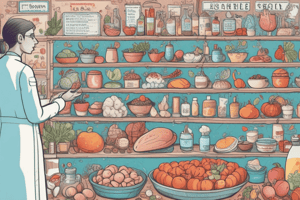Podcast
Questions and Answers
What are the four major kinds of pathogens that can cause food-borne illness?
What are the four major kinds of pathogens that can cause food-borne illness?
Bacteria, viruses, protozoa, and fungi
Which type of bacteria can live without oxygen, such as in canned or vacuum-packed foods?
Which type of bacteria can live without oxygen, such as in canned or vacuum-packed foods?
Some bacteria
What is the term for the inactive resistant forms that some bacteria transform into when living conditions are less than ideal?
What is the term for the inactive resistant forms that some bacteria transform into when living conditions are less than ideal?
Spores
What is the term for the process by which some types of bacteria produce toxins that cause food intoxication?
What is the term for the process by which some types of bacteria produce toxins that cause food intoxication?
What are some common sources of Staphylococcus aureus?
What are some common sources of Staphylococcus aureus?
Which pathogens can cause food-borne illness, and include forms of Campylobacter, Clostridium, Escherichia, Listeria, Salmonella, and Staphylococcus?
Which pathogens can cause food-borne illness, and include forms of Campylobacter, Clostridium, Escherichia, Listeria, Salmonella, and Staphylococcus?
What is the purpose of Table 12.3?
What is the purpose of Table 12.3?
Which two types of pathogens are responsible for most cases of food-borne illness in the United States?
Which two types of pathogens are responsible for most cases of food-borne illness in the United States?
What type of foods are commonly associated with Bacillus cereus toxin, and what are the typical signs and symptoms of infection?
What type of foods are commonly associated with Bacillus cereus toxin, and what are the typical signs and symptoms of infection?
Which bacterium can be found in honey and can cause symptoms such as vomiting, diarrhea, and blurred vision?
Which bacterium can be found in honey and can cause symptoms such as vomiting, diarrhea, and blurred vision?
What is the commonly infected food source of Escherichia coli O157:H7, and what are the typical signs and symptoms?
What is the commonly infected food source of Escherichia coli O157:H7, and what are the typical signs and symptoms?
What are the common sources of Listeria monocytogenes, and what are the typical signs and symptoms?
What are the common sources of Listeria monocytogenes, and what are the typical signs and symptoms?
Which virus does not secrete toxins and therefore does not cause food intoxication?
Which virus does not secrete toxins and therefore does not cause food intoxication?
What are the common sources of Yersinia enterocolitica, and what are the typical signs and symptoms?
What are the common sources of Yersinia enterocolitica, and what are the typical signs and symptoms?
What is the source of the data presented in the tables about bacteria and viruses?
What is the source of the data presented in the tables about bacteria and viruses?
How do scientists identify bacteria?
How do scientists identify bacteria?
What is the difference between food infection and food intoxication?
What is the difference between food infection and food intoxication?
Which bacterium is commonly associated with raw oysters, clams, and crabs, and can cause symptoms such as fever, vomiting, and diarrhea?
Which bacterium is commonly associated with raw oysters, clams, and crabs, and can cause symptoms such as fever, vomiting, and diarrhea?
What is the typical incubation period of hepatitis A virus?
What is the typical incubation period of hepatitis A virus?
What is the common mode of transmission of norovirus?
What is the common mode of transmission of norovirus?
What is the significance of aflatoxins in food safety?
What is the significance of aflatoxins in food safety?
What are the common signs and symptoms of rotavirus infection?
What are the common signs and symptoms of rotavirus infection?
What is the concern related to certain varieties of wild mushrooms?
What is the concern related to certain varieties of wild mushrooms?
What are the common sources of foodborne illness caused by protozoa and parasitic worms?
What are the common sources of foodborne illness caused by protozoa and parasitic worms?
What is the significance of norovirus vaccine development?
What is the significance of norovirus vaccine development?
How do fungi contribute to food spoilage?
How do fungi contribute to food spoilage?
What is the association between aflatoxins and liver cancer?
What is the association between aflatoxins and liver cancer?
What are the typical signs and symptoms of a norovirus infection?
What are the typical signs and symptoms of a norovirus infection?
What is the primary source of Cryptosporidium infection in foods?
What is the primary source of Cryptosporidium infection in foods?
What is the typical incubation period for Toxoplasma infection?
What is the typical incubation period for Toxoplasma infection?
What are the symptoms of Anisakis infection?
What are the symptoms of Anisakis infection?
What is the primary source of Trichinella infection in foods?
What is the primary source of Trichinella infection in foods?
Why is it important for pregnant women to avoid contact with cat feces?
Why is it important for pregnant women to avoid contact with cat feces?
What is the definition of a parasite?
What is the definition of a parasite?
What is the significance of Table 12.5 in the context of food-borne illness?
What is the significance of Table 12.5 in the context of food-borne illness?
What is the outcome for most Americans who become infected with parasitic worms that are found in the United States?
What is the outcome for most Americans who become infected with parasitic worms that are found in the United States?
Flashcards are hidden until you start studying
Study Notes
Common Food-Borne Pathogens
- Bacteria, viruses, protozoa, and fungi are the major kinds of pathogens that can cause food-borne illness in the United States.
- Bacteria and viruses are responsible for most cases of food-borne illness in the United States.
Bacterial Pathogens
- Examples of bacterial pathogens include:
- Staphylococcus aureus, often found in improperly cooked or handled beef, poultry, eggs, and foods made with eggs
- Campylobacter jejuni, often found in raw, undercooked poultry; raw milk; and contaminated water
- Clostridium botulinum, often found in vacuum-packed foods, improperly canned foods, and low-acid foods; honey may contain spores
- Escherichia coli O157:H7, often found in raw ground beef, raw seed sprouts, raw leafy greens, fresh fruit, raw milk, unpasteurized juices, and foods contaminated with feces
- Listeria monocytogenes, often found in raw meat, poultry, raw milk, fresh soft cheese made from raw milk, liver pâté, smoked seafood, deli meats, hot dogs, and raw vegetables
- Salmonella species, often found in meat, poultry, seafood, and eggs; raw seed sprouts; raw vegetables; and unpasteurized juice
- Shigella species, often found in unclean water; raw vegetables, herbs, and other foods contaminated with feces as a result of poor food handling and personal hygiene practices
- Vibrio vulnificus, often found in raw oysters, clams, crabs, and other raw or undercooked seafood; unclean water
- Yersinia enterocolitica, often found in raw vegetables, undercooked pork, contaminated water, and unpasteurized milk
- Typical signs and symptoms of bacterial food-borne illnesses include:
- Diarrhea
- Abdominal cramps
- Vomiting
- Fever
- Headache
- Muscle aches
- Watery diarrhea (sometimes bloody)
- Nausea
- Muscular weakness
- Difficulty swallowing
- Blurry or double vision
- Incubation periods for bacterial food-borne illnesses vary, ranging from 1-7 hours to 1-2 weeks.
Viral Pathogens
- Viruses are another common source of food-borne infection.
- Examples of viral pathogens include:
- Norovirus, often found in food, water, or surfaces contaminated with infected feces
- Rotavirus, often found in food, water, or objects contaminated with infected feces
- Hepatitis A virus (HAV), often found in food or water contaminated with HAV from feces
- Typical signs and symptoms of viral food-borne illnesses include:
- Vomiting
- Diarrhea
- Abdominal cramps
- Fever
- Headache
- Muscle aches
- Watery, non-bloody diarrhea
- Nausea
- Loss of appetite
- General weakness
- Jaundice
- Liver enlargement
- Dark-colored urine
- Incubation periods for viral food-borne illnesses vary, ranging from 12 hours to 4 weeks.
Fungal Pathogens
- Fungi, such as molds, yeast, and mushrooms, are simple life forms that live on dead or decaying organic matter.
- Certain fungi, such as button mushrooms and the mold in blue cheese, are beneficial and edible.
- However, some fungi are responsible for spoiling foods or causing respiratory problems or allergic reactions in sensitive people.
- Aflatoxins, produced by certain molds, can cause severe illness, particularly liver damage, and even death when consumed.
- Tree nuts, peanuts, rice, and corn stored under warm, humid conditions can become sources of aflatoxins.
Protozoal and Parasitic Worm Pathogens
- Protozoa, such as Giardia and Cryptosporidium, are single-celled microorganisms that have a more complex cell structure than bacteria.
- Examples of protozoal pathogens include:
- Cryptosporidium, often found in foods prepared by people whose hands were contaminated with infected feces; fresh juices, produce, and milk
- Giardia, often found in contaminated water, including water from lakes, streams, and swimming pools
- Parasitic worms, such as Trichinella and Anisakis, can contaminate food or water.
- Examples of parasitic worm pathogens include:
- Trichinella, often found in raw or undercooked infected meat, especially pork, bear, seal, and walrus meat
- Anisakis, often found in raw or undercooked infected seafood
- Typical signs and symptoms of protozoal and parasitic worm food-borne illnesses include:
- Diarrhea
- Abdominal pain
- Fever
- Nausea
- Vomiting
- Fatigue
- Facial swelling
- Muscle pain
- Abdominal discomfort
- Rash
Studying That Suits You
Use AI to generate personalized quizzes and flashcards to suit your learning preferences.




